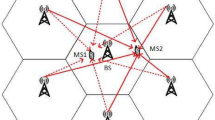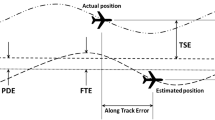Abstract
The monitoring of an aircraft during its flight phases is crucial to the performance of air-to-ground (A/G) communication designed for air traffic management (ATM) purposes. Due to the everyday increasing air traffic, A/G communications have been transferred from the congested very high frequency band to occupy the guard bands between adjacent distance measurement equipment (DME) channels within the L-Band. However, the inlayed channels, called L-Band digital aeronautical communications (LDACS) channels, experience severe interference with the coexisting DME channels. The previous work depends on both DME interference detection and mitigation techniques. In this paper, a DME interference mitigation technique is proposed to improve the performance of the LDACS type I (LDACSI) system without requiring the detection process. The proposed technique depends on the underlay spectrum sharing for LDACSI signal. The underlay spectrum sharing concept is performed using spread spectrum technique. The spread spectrum technique is applied based on the idea of multiplexing the in-phase and the quadrature components of LDACSI signal by two Walsh orthogonal spreading codes in which they are transmitted over the quadrature branch. The resulting combined baseband signal is transmitted only over the quadrature branch then RF is up-converted to form the band pass signal in the presence of the DME interfering signal. Therefore, the spread LDACSI signal is friendly coexist on the top of DME interference signal. Moreover, the simulation results shows that the proposed underlay spectrum sharing for LDACSI system provides lower bit error rate and less complexity compared to the previous work.










Similar content being viewed by others
Data Availability
Enquiries about data availability should be directed to the authors.
References
Schnell, M., Epple, U., Shutin, D., & Schneckenburger, N. (2014). LDACS: Future aeronautical communications for air-traffic management. IEEE Communications Magazine, 52(5), 104–110.
SESAR homepage. (2014). https://www.sesarju.eu/.
NextGen homepage. (2014). https://www.faa.gov/nextgen/.
van den Boogaard, K. (2003). Agenda item 2: future air/ground data link systems—the IATA position on the use of 8.33 kHz, document AMCP/8- WP/40, Aeronautical Mobile Communication Panel.
Zeltser, M. J., Morser, F. R., Long, P., & Box, F. (2003). ‘‘White paper: Spectrum depletion analysis,’’ The MITRE Corp., McLean, VA, USA, White Paper MP 03W0000068.
Schreckenbach, F., Leconte, K., Baudoin, C., Kissling, C., Bauer, C., & Ayaz, S. (2008). Functional building blocks for an integrated aeronautical IP-network. In 2008 Integrated Communications, Navigation and Surveillance Conference. (ICNS).( pp. 1–9).
ICAO/AMCP. (2016). Future Aeronautical Mobile Communications Scenario—Report on Agenda Item 2, Appendix a, 8th Meeting of the Aeronautical Mobile Communications Panel (Contribution), accessed on Jan. 15, 2016. [Online]. Available: http://www.icao.int/safety/acp/Inactive%20working%20groups%20library/ AMCP%208/AMCP866-ycr2A.pdf
Schnell, M., Brandes, S., Gligorevic, S., Rokitansky, C.-H., Ehammer, M., Gräupl, T., et al. (2008). B-AMC Broadband Aeronautical Multi Carrier Communications, Integrated Communications Navigation and Surveillance Conference, Bethesda, MD.
Sajatovic, M. et al. (2009). L-DACS1 system definition proposal: Deliverable D2. Eur. Org. Safety Air Navigat., Brussels, Belgium. Eurocontrol Study Report.
Fistas, N. (2009). L-DACS2 system definition proposal: Delivrable D2. Eurocontrol, Brussels, Belgium, Tech. Rep. 1.0, Version 1.
Neji, N., De Lacerda, R., Azoulay, A., Letertre, T., & Outtier, O. (2013). Survey on the future aeronautical communication system and its development for continental communications. IEEE Transactions on Vehicular Technology, 62(1), 182–191.
Zhidkov, S. V. (2003). Impulsive noise suppression in OFDM based communication systems. IEEE Transactions on Consumer Electronics, 49(4), 944–948.
Epple, U., Shutin, D., & Schnell, M. (2012). Mitigation of impulsive frequency-selective interference in OFDM based systems. IEEE Wireless Communications Letters, 1(5), 484–487.
Brandes, Sinja, & Schnell, Michael. (2009). Interference mitigation for the future aeronautical communication system in the L-band. 7th International Workshop on Multi-Carrier Systems & Solutions (MC-SS 2009) (pp. 375–384). Herrsching, Germany: Springer.
Epple, U., & Schnell, M. (2011). Overview of interference situation and mitigation techniques for LDACS1. In Digital Avionics System Conference.
Xiao, Y., Xie, J., Yang, J., & Zhang, T. (2016). A time-domain correlative interference mitigation in LDACS1. In 2016 Integrated Communications Navigation and Surveillance (ICNS), Herndon, VA. (pp. 2D3–1–2D3–9).
Haring, J., & Vinck, A. J. H. (2003). Iterative decoding of codes over complex numbers for impulsive noise channels. IEEE Transaction on Information Theory, 49(5), 1251–1260.
Zhidkov, S. V. (2003). Impulsive noise suppression in OFDM based communication systems. IEEE Consumer Electronics, 49(4), 944–948.
Ambede, A., Vinod, A. P., & Madhukumar, A. S. (2016). Design of a low complexity channel filter satisfying LDACS1 spectral mask specifications for air-to-ground communication. In 2016 Integrated Communications Navigation and Surveillance (ICNS), Herndon, VA. (pp. 7E3–1–7E3–7).
Hirschbeck, M., & Huber, J. B. (2015). Block based frequency selective mitigation of pulsed interference in the L-band. In International ITG Conference on Systems, Communications and Coding (SCC).
Hirschbeck, M., & Huber, J. B. (2016). OFDM receiver structure for a subband selective mitigation of time-variant interference. IEEE Transactions on Vehicular Technology, 65(10), 8130–8144.
Zhidkov, S. (2008). Analysis and comparison of several simple impulsive noise mitigation schemes for OFDM receivers. IEEE Transactions on Communications, 56(1), 5–9.
Bueckert, D. (2010). SAIT ELCM 355. Course Handouts.
Sajatovic, M., & Schnell, M. (2010). Updated LDACS1 prototype specification [Internet]. Brussels: European Organisation for the Safety of Air Navigation (Eurocontrol) [cited 2010 December 3]. Available from: http://www.ldacs.com/wp-content/uploads/2014/02/ LDACS1-Updated-Prototype-Specifications-D3-Deliverable.pdf.
Brandes, S., Gligorevic, S., Ehammer, M., Gra¨upl, T., & Dittrich, R. (2007). Expected B-AMC System Performance, Doc. ref. CIEA15EN506.11.
Miodrag, S., Haindl, B., Epple, U., & Gra¨upl, T. (2011). Updated LDACS1 system specification [Internet]. Brussels: European Organisation for the Safety of Air Navigation (Eurocontrol) [cited 2011 April 8]. Available from: http://www.ldacs.com/wpcontent/uploads/2014/02/LDACS1-Updated-Specification-Proposal-D2-Deliverable.pdf.
Sajatovic, M., Haindl, B., Epple, U., & Gr¨aupl, T. (2011). Updated LDACS1 System Specification. Doc. ref. EWA04-1-T2-D1.
EUROCONTROL/FAA Future Communications Study Operational Concepts and Requirements Team. (2007). Communications operating concept and requirements for the future radio system (COCR). tech. rep., v. 2.0.
Brandes, S., Gligorevic, S., Ehammer, M., Gr¨aupl, T., & Dittrich, R. (2007). Expected B-AMC System Performance. Doc. ref. CIEA15EN506.11.
Funding
The authors have no financial or proprietary interests in any material discussed in this article.
Author information
Authors and Affiliations
Corresponding author
Ethics declarations
Conflict of interest
The authors have not disclosed any competing interests.
Additional information
Publisher's Note
Springer Nature remains neutral with regard to jurisdictional claims in published maps and institutional affiliations.
Rights and permissions
Springer Nature or its licensor holds exclusive rights to this article under a publishing agreement with the author(s) or other rightsholder(s); author self-archiving of the accepted manuscript version of this article is solely governed by the terms of such publishing agreement and applicable law.
About this article
Cite this article
Abd-Elaty, E., Zekry, A., El-Agooz, S. et al. Underlay Spectrum Sharing with L-Band Distance Measuring Equipment for Aeronautical Communications. Wireless Pers Commun 128, 2363–2377 (2023). https://doi.org/10.1007/s11277-022-10045-0
Accepted:
Published:
Issue Date:
DOI: https://doi.org/10.1007/s11277-022-10045-0




